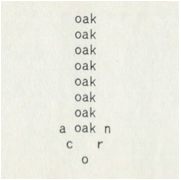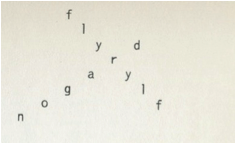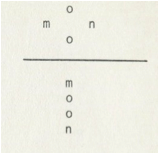|
Marlene Mountain’s Visual Haiku
by Dara Johnson
October 25, 2015
Marlene Mountain is not only a poet but also a renowned painter. For many years she has integrated her paintings with haiku. She has been interested in haiku since 1964 and has been published in journals since 1969. She takes the writing of haiku to a different level considering many of her haiku are one line or take the visual form of a shape. Her different way of writing haiku intrigued me realizing that writing haiku do not have to be three lines. In the introduction to Cur*rent: Linked Haiku Marlene states, “What surrounds a haiku, a context, an attitude, contributes mightily to its energy.” She goes on to say, “Without all of that, one could say that it’s rather like a grade school poem” (page 10). Marlene’s book, the old tin roof, published in 1976 has many examples of Marlene’s one liner haiku and visual haiku where she visually creates the hint of energy around the words and image of the poem. Marlene is a poet with much imagination and talent so you see what she sees that is what makes her an interesting author. She does not use the same format as most haiku authors do—one line or a design forms with her poetry. All of the following examples of her visual haiku are from the old tin roof.

I love the way she writes a single word with one dropped letter. This changes how the audience might read the haiku. I can see the single raindrop falling from a rose pedal or from a gutter atop a house. This reflects a rain that has happened or is just beginning. I can even smell the heavy rain coming or leaving. The smell of rain is a wonderful smell, clean and fresh.

The placing of the letters on this haiku is wonderful. I can see the violet flower with the vibrant color of purple. The placement of the letters brings out how powerful she can be with her words. I see a little girl running across a field of these beautiful flowers with butterflies above her head. Your imagination can just run away with Marlene’s haiku.

When I flipped to this page in her book, I fell in love with her visual show of an acorn falling from a big oak tree. The arrow pointing down states the tree could be a big tree, which is what I imagine. I see that there have been many acorns that have dropped to the ground from this big tree and that there are going to be many more.

This one made me feel like it was a beautiful spring day, in a field with those violets and a butterfly has just landed on a violet. The butterfly’s wings are closed as if resting on the violet or a little girl’s nose. I can smell the spring day all the tall grass in the field and me sneezing every once in a while. The imagination can run wild with her visual word placement. The word starts at the top and flows all the way down and back up showing how the butterfly has just flown and landed.

Marlene’s haikus make me smile every time I read one. “krik’ it” falls into this same category. The spelling makes me think of hooked on phonics. I love the incorrect spelling of this word. It shows how Marlene sees this cricket and how it is singing away. The way the “u” is above the “I” showing as a musical note. I can see the cricket sitting by himself not knowing someone is watching him playing his own tune.

Marlene has an interesting way of thinking on this haiku. I can see the dead cat laying in the middle of the road with its paws straight up in the air. I love cats so this one is sad to me, even though I know I see dead animals on the road all the time. Riga mortise has set in so his poor little feet are pointing straight to the sky.

This one took me a minute to understand but that is what I like about Marlene she makes you think. My eyes first saw the fly typed twice, which I thought of fly-fishing right away. The word dragon was the next word I looked at and thought that is nice until I looked at her placement. It looks as if the dragonfly is flying. It is amazing how some of her haikus are like puzzles and even though you may find the word she wrote there is more to it causing you to gaze more at it.

The one-legged grasshopper shedding his skin. This is another unusual haiku because the grasshopper is one-legged and it is stated twice as if to restated what we already now. This haiku then makes you think, since it is shedding its skin, it is a young grasshopper so was it born with only one leg or did something happen to cause him to have only one. This could also state that only one leg was shedding at this time. I love the way you can see this haiku as a grasshopper with the placement of the word shedding skin going up then down as it is the grasshoppers one-leg.

This haiku I am still not sure I understand. I first looked at this and saw the moon, which is wrote in a circle to show it as the moon. It is above a line that could be the equator and then another moon but wrote straight down as if to say below the equator you will be awake. I am not sure I have perceived this one correctly at all. It almost looks as if it is a flower and with the help of the Internet there is such a flower as the moonflower. This is exactly why this author has my attention. The moonflower is a beautiful flower that will open up at night giving a wonderful aroma in the evening.

This one does not have the placement as many of her others. Although it is basically two lines she has an interesting meaning. I can see someone typing which is the tap, tap, tap but the letters of butterfly are placed between each tap which make me see a butterfly flapping his wings to the tap of the typewriter. The way it is wrote helps you see the person typing and then the “ding” as it returns. I can tell this was wrote a while back since typewriters are almost extinct. Marlene is a wonderful haiku writer she writes from her experiences and feelings keeping your imagination alive.
Works Cited
Mountain, Marlene, Francine Porad, with an introduction by Randy Brooks. Cur*rent: Linked Haiku. Mercer Island, WA: Vandina, 1998. Print.
Wills, Marlene Morelock. The Old Tin Roof: Haiku, Senryu, Dadaku. Hampton, TN: M.M. Wills, 1976. Print.
|